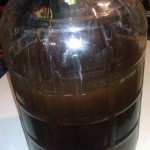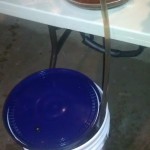After about two months of conditioning in a secondary vessel, I felt it was time to bottle the braggot. The bottle were all cleaned and sanitized over the weekend and the braggot seemed read to be racked and primed.
Since I am looking to get a nice carbonation going in the bottle, somewhere in the back of my mind there is some concern that the yeast may not be viable enough to eat the priming sugar, but we’ll see. This Scottish Ale yeast seems strong “like bull” and I am confident the braggot will carbonate and will continue to condition, clear, and become a delightful autumn time beverage.
The few tastings I have had of the braggot over the course of its young life have not been delightful. There is still a hotness from the alcohol and a strong bitterness from the Centennial hops. I have learned that you can’t judge a mead by the early tastings but there are some elements of the flavor that should get stronger like its malty background.
The alcohol burn and the hop bitterness should mellow over time. I think I need to bottle it up and forget about it for a few months. In the near future, on some late October night, I will come across this forgotten box of braggot bottles and I will be most pleased.
I can picture serving it in a tall Pilsner glass showing off its tawny color and rocky head. Signals of honey and malt with hops will be ready on the nose. The flavor will be bold and slightly warming and will be a perfect compliment to a long day of raking leaves.
But for now, it’s all about focusing on keeping everything clean and neat and making sure that the amount of air that gets into the finished braggot stays to a minimum.



Leave a Reply